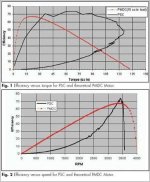Hi Don
You are right about the desire to maintain a constant cadence no matter what the terrain, speed or incline. But I think it begs the statement "If you cannot find that 'sweet spot' (which is actually a range) with a choice of (say) 24 bike gears to choose from and a variable speed throttle, then I am not sure there is any system that will meet that riders requirements".
Again, I would stress, take a step back in understanding how to use an electric system. The rider should ride the bike just like normal; normal cadence, normal gear selection, normal applied force. Again, start by using approx the same amount of effort as on a flat, wind free road.
Now if a hill comes, you would normally drop a gear to maintain your cadence OR apply more effort to maintain your cadence. Now with a powered system you have a THIRD option, twist the throttle to 'supply' the additional effort. But twist it only enough to give the additional effort required/desired. If you find that you are supplying your maximum effort and maximum throttle but it is still 'too much', then drop down a gear. This will/should result in the need to drop some effort, either from the motor or the rider; rider's choice.
Want more speed, similar technique applies. Normally you would apply more effort to maintain your cadence and then lift a gear to increase speed. But now you also have the option of a powered system to 'supply' the additional effort.
HOWEVER, you will get to a point where no matter how much effort you or the motor supply, you will not go faster or up Mount Everest.
This goes for ANY system.
The addition of a powered system should not greatly change the overall ride technique of a person. However, just like getting into a totally different model car (sedan to sports); you should get used to it by driving it with all the same basic skills you learnt from the last car; it may not perform exactly the same or 'at its best', AT FIRST. But with a bit of practice you come to understand why this car is different and after not too long you are driving it using all the same techniques you used in your old car; but with a big smile on your face

 Is there anyone out there who has experience riding a Tandem bike, as I believe it would be a similar learning experience. Maybe they could offer some more insight into how best to work/adapt to riding with dual power sources.
Is there anyone out there who has experience riding a Tandem bike, as I believe it would be a similar learning experience. Maybe they could offer some more insight into how best to work/adapt to riding with dual power sources.
Cheers
Allan
PS. For the 'record", the motors nominal speed at load is 2600rpm (it is all on the label). This is internally geared down by 9.33 (on the label), resulting in drive shaft speed of 279 rpm. The supplied external gears are 14T drive and 48T driven, resulting in nominal crank speed of 81 rpm. I would like to think most people would see that there is just a possibility that the rpm was ACTUALLY designed to meet the average persons cadence of 75 to 85 rpm with a 10% tolerance band.
In addition, ALL front gear rings can be changed individually. So that means the driven ring can range from 54T (cadence 72 rpm) to 38T (cadence 102 rpm) using standard 4 hole, 104 BCD gear rings.
NOTE: This is not the motors maximum speed, but the top speed at which it is operating in the most efficient band/range. It is also not it max power. You can increase the throttle that bit more to get max power, but the 'cost' is lowered efficiency (for ANY motor).
PPS. With each kit is supplied a "How to ride" document of approx 3 pages. It outlines battery usage/maintenance, how to interpret LEDs of throttle and how to start out riding. At the end of the day, just like any other worthwhile pursuit in life, it then comes down to practice.


